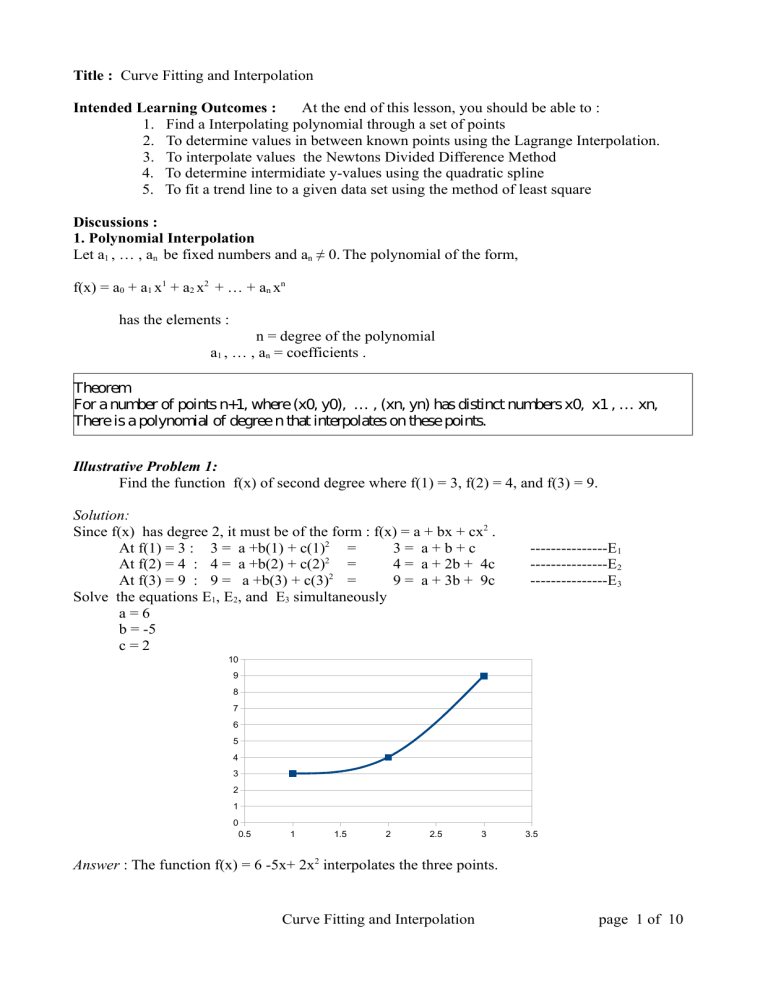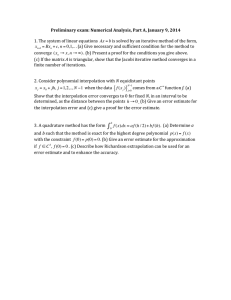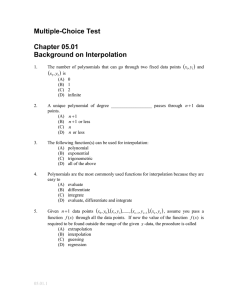
Title : Curve Fitting and Interpolation Intended Learning Outcomes : At the end of this lesson, you should be able to : 1. Find a Interpolating polynomial through a set of points 2. To determine values in between known points using the Lagrange Interpolation. 3. To interpolate values the Newtons Divided Difference Method 4. To determine intermidiate y-values using the quadratic spline 5. To fit a trend line to a given data set using the method of least square Discussions : 1. Polynomial Interpolation Let a1 , … , an be fixed numbers and an ≠ 0. The polynomial of the form, f(x) = a0 + a1 x1 + a2 x2 + … + an xn has the elements : n = degree of the polynomial a1 , … , an = coefficients . Theorem For a number of points n+1, where (x0, y0), … , (xn, yn) has distinct numbers x0, x1 , … xn, There is a polynomial of degree n that interpolates on these points. Illustrative Problem 1: Find the function f(x) of second degree where f(1) = 3, f(2) = 4, and f(3) = 9. Solution: Since f(x) has degree 2, it must be of the form : f(x) = a + bx + cx2 . At f(1) = 3 : 3 = a +b(1) + c(1)2 = 3= a+b+c At f(2) = 4 : 4 = a +b(2) + c(2)2 = 4 = a + 2b + 4c At f(3) = 9 : 9 = a +b(3) + c(3)2 = 9 = a + 3b + 9c Solve the equations E1, E2, and E3 simultaneously a=6 b = -5 c=2 ---------------E1 ---------------E2 ---------------E3 10 9 8 7 6 5 4 3 2 1 0 0.5 1 1.5 2 2.5 3 3.5 Answer : The function f(x) = 6 -5x+ 2x2 interpolates the three points. Curve Fitting and Interpolation page 1 of 10 2. Lagrange Interpolation Usage : To determine values in between known points in a data set Lagrange interpolating polynomial can be written as n f n ( x )= Σ Li ( x ) f ( x i ) i= 0 n Π x−x j where : Li ( x )= Π → defined as "product of" j= 0 x i −x j j≠i For Example 1st degree : x−x 1 x−x 0 f 1 ( x )= f ( x o)+ f ( x 1) x 0 −x 1 x1 −x 0 2nd degree : f 3 ( x )= f 2 ( x )= 3nd degree : ( x−x 1 )( x−x 2 )( x−x 3 ) ( x 0 −x 1)( x 0 −x2 )( x 0 −x 3 ) f ( x o )+ ( x−x 1 )( x−x 2 ) ( x−x 0)( x−x 2 ) ( x−x 0 )( x−x 1 ) f ( x o )+ f ( x 1 )+ f (x ) ( x 0 −x 1 )( x 0 −x2 ) ( x 1 −x 0)( x 1−x 2 ) ( x 2−x 0 )( x 2 −x 1 ) 2 ( x−x 0 )( x−x 2 )( x−x 3 ) ( x−x 0)( x−x 1)( x−x 3) ( x−x 0 )( x−x 1 )( x−x 2 ) f ( x 1 )+ f ( x 2 )+ f ( x 3) ( x 1−x0 )( x1−x 2)( x 1−x 3) ( x 2−x 0 )( x 2 −x 1 )( x2−x 3 ) ( x3−x 0)( x 3 −x 1 )( x3 −x 2 ) Illustrative Problem 2: Using the data points shown below estimate the value of y if x = 1.6, Use the Lagrange third - degree interpolation. f 3 ( x )= x y = f(x) x0 = 1 3 x1 = 2 4 x2 = 3 9 x3 = 4.6 18 Solution : ( x−x 1 )( x−x 2 )( x−x 3 ) ( x 0 −x 1)( x 0 −x2 )( x 0 −x 3 ) f 3 ( 1 .6 )= f ( x o )+ ( x−x 0 )( x−x 2 )( x−x 3 ) ( x−x 0)( x−x 1)( x−x 3) ( x−x 0 )( x−x 1 )( x−x 2 ) f ( x 1 )+ f ( x 2 )+ f ( x 3) ( x 1−x0 )( x1−x 2)( x 1−x 3) ( x 2−x 0 )( x 2 −x 1 )( x2−x 3 ) ( x3−x 0)( x 3 −x 1 )( x3 −x 2 ) ( 1. 6−2 )( 1. 6−3 )( 1. 6−4 . 6 ) (1 . 6−1 )( 1 .6−3 )( 1. 6−4 . 6 ) (1 . 6−1 )( 1 .6−2 )( 1. 6−4 . 6 ) (1 . 6−1 )( 1 .6−2 )( 1. 6−3 ) 3+ 4+ 9+ 18 (1−2 )(1−3 )( 1−4 .6 ) ( 2−1 )( 2−3 )( 2−4 . 6 ) (3−1 )( 3−2 )( 3−4 . 6 ) ( 4 . 6−1 )( 4 . 6−2 )( 4 . 6−3 ) f3(1.6) = 0.7 + 3.87692 – 2.025+0.40385 ≈ 2.9558 (answer) Curve Fitting and Interpolation page 2 of 10 3. Newton Divided Difference Method Usage : To determine values in between known points in a data set Newton Divided Difference interpolating polynomial can be written as f n ( x ) =b o +b1 ( x−x o ) +b 2 ( x−x o )( x−x 1 ) + .. .b n ( x−x o )( x−x 1 ) . .. ( x−x n−1 ) where b o =f ( x o ) b1 =f ( x1 ,xo ) . . . bn =f ( x n ,x n−1 , . .. ,x 1 ,x0 ) the fuctions f are defined by 1st term f ( x i ,x j ) = f ( x j )−f ( x i ) nd 2 term f ( x i ,x j ,x k )= x j −xi f ( x k ,x j ) −f ( x j ,xi ) x k −x i . . . nth term f ( x n ,x n−1 ,. .. ,x 1 ,x 0 )= f ( x n ,x n−1 ,. .. x 1 )−f ( x n−1 ,x n−2 ,. .. x 0 ) x n −x o Illustrative Problem 2: Using the data points shown below estimate the value of y if x = 1.6, Use the Newton Divided Difference interpolation. x y = f(x) x0 = 1 3 x1 = 2 4 x2 = 3 9 x3 = 4.6 18 Curve Fitting and Interpolation page 3 of 10 Solution : 1. Prepare the table i x f(x) 0 1 3 1 2 4 2 3 9 3 4.6 18 f(xi, xj) f(xi, xj, xk) f(xi, xj, xk, xl) 2. Extract the coefficients b0 = 3 b1 = 1 b2 = 2 b3 = -0.488782 3. Use the formula to interpolate f(1.6) f 3 ( x ) =bo +b1 ( x−x o ) +b 2 ( x−x o )( x−x 1 ) +b 3 ( x−x o )( x−x 1 )( x−x 2 ) f3(1.6) = 3+ 1(1.6-1) + 2(1.6-1)(1.6-2) -0.488782(1.6-1)(1.6-2)(1.6-3) ≈ 2.9558 interestingly f2(1.6) = 3+ 1(1.6-1) + 2(1.6-1)(1.6-2) f1(1.6) = 3+ 1(1.6-1) (answer) = 3.12 , quadratic = 3.6 , linear 4. Quadratic Spline Usage : To determine values in between known points in a data set using a spline Consider the data set shown below. We want to draw a series of quadratic curve to link the points given such that the overall curve is "smooth". There will be three quadratic functions for this data set. One for each set of adjacent points. 20 x 1 3 6 10 y 1 -2 15 9 20 15 15 10 10 5 5 0 0 -5 0 2 4 6 8 10 12 Plotted points -5 0 2 4 6 8 10 Smooth spline curve The following conditions apply : 1. y-values at interior points must be equal 2. function values at end points are equal to y-values at end points 3. the slopes of the functions meeting at an interior point are equal 4. the second derivative at the first point is zero Curve Fitting and Interpolation page 4 of 10 12 Illustrative Problem 3: Consider the data set shown below. Obtain the quadratic spline to fit the data set shown below. Estimate the value of y when x = 8. x 1 3 6 10 y 1 -2 15 9 *Cubic Spline sample Solution : 1. The are three quadratic functions to fit the data set y1 = a1x2+ b1x +c1 y2 = a2x2+ b2x +c2 y3 = a3x2+ b3x +c3 2. Apply conditions 2.1 "y-values at interior points must be equal" At x = 3; a1(9) + b1(3) +c1 = -2 At x = 3; a2(9) + b2(3) +c2 = -2 At x = 6; At x = 6; a2(36) + b2(6) +c2 = 15 a3(36) + b3(6) +c3 = 15 2.2 "function values at end points are equal to y-values at end points" At x = 1; a1(1) + b1(1) +c1 = 1 At x = 10; a3(100) + b3(10) +c3= 9 2.3 "the slopes of the functions meeting at an interior point are equal" y1' = y2' At x = 3; 2a1(3) + b1 = 2a2(3) + b2 6a1 + b1 - 6a2 – b2 = 0 y2' = y3' At x = 6; 2a2(6) + b2 = 2a3(6) + b3 12a2 + b2 - 12a3 – b3 = 0 2.4 "the second derivative at the first point is zero" a1 = 0 , straight line from point1 to point 2 Curve Fitting and Interpolation page 5 of 10 3. Determine the unknown constants In matrix form Solve the system of linear equations : a1 = 0 b1= -0.8571 c 1= 1.8571 a2 = 2.1746 b2= -13.9048 c2= 20.1429 a3 = -3.4226 b3= 53.2619 c 3= -181.3571 4. Estimate the value of y when x = 8. y3 = a3x2+ b3x +c3 = -3.4226(8)2 + 53.2619(8) -181.3571 , estimated value, Answer. 5. Least Square Method Linear Regression uses a straight line to fit a given set paired data set (x, y). General Form y = a + bx + e where : a = intercept b = slope e = error we can express the equation in the form e = y - a - bx Minimize the error e using S r =∑ e 2 =∑ ( y−a−bx )2 where : n ∑ xy−∑ x ∑ y b= 2 n ∑ x 2 − (∑ x ) a= ȳ−b x̄ Error Analysis St = Σ(y- y)2 Curve Fitting and Interpolation page 6 of 10 r 2= S t −S r St , -1 < r < 1.0 (perfect positive fit) correlation coefficient Illustrative Problem 4: Fit a straight trend line using the method of least square from the following data set, and find the trend values. Estimate y when x = 8. Determine the correlation coefficient r. x 1 3 6 10 y 1 -2 15 9 Solution: 1. Populate the table Σ x 1 3 6 10 20 y 1 -2 15 9 23 x2 1 9 36 100 146 y2 1 4 225 81 311 xy 1 -6 90 90 175 2. Calculate the mean values , a, and b ∑ x = 20/ 4 = 5 x̄= n ∑ y = 23 /4 = 5.75 ȳ= n b= n ∑ xy−∑ x ∑ y n ∑ x 2 − (∑ x ) b = 1.304348 2 = 4 ( 175 )−20 ( 23 ) 2 4 (146 ) – 20 a= ȳ−b x̄ = 5.75 – 1.304348(5) = -0.771739 y = -0.771739 + 1.304348x (trend line) 3. Estimate y when x = 8. y = -0.771739 + 1.304348x (trend line) y = -0.771739 + 1.304348(8) ^y =11 .2065 , estimate , Answer Curve Fitting and Interpolation page 7 of 10 4. Perform Error Analysis n=4, y= 5.75, a = -0.771739, b =1.304348 x y (y- y)2 (y-a-bx)2 1 1 22.5625 0.2185 3 -2 60.0625 26.4330 6 15 85.5625 63.1334 10 9 10.5625 10.7043 Σ 20 23 178.75 100.4891 St Sr S −S r 2 = t r = (178.75-100.4891)/178.75 =0.437823 St r = 0.66168 , correlation coeffient Curve Fitting and Interpolation page 8 of 10 Self Assessment(Problem Set) : P1. Find the function f(x) of second degree where f(2) = 3, f(6) = 4, and f(9) = 9. P2. Using the data points shown below estimate the value of y if x = 7, Use the Lagrange third - degree interpolation. x y = f(x) 2 3 6 4 9 9 11 10 P3. Using the data points shown below estimate the value of y if x = 7, Use the Newton Divided Difference interpolation. x y = f(x) 2 3 6 4 9 9 11 10 P4. Consider the data set shown below. Obtain the quadratic spline to fit the data set shown below. Estimate the value of y when x = 7. x y = f(x) 2 3 6 4 9 9 11 10 P5: Fit a straight line trend using the method of least square from the following data set, and find the trend values. Estimate y when x = 8. Determine the correlation coefficient r. x y = f(x) 2 3 6 4 9 9 11 10 Curve Fitting and Interpolation page 9 of 10 References : 1. Applied Numerical Methods with MATLAB for Engineers and Scientist Steven C. Chapra, McGraw Hill International Edition c.2005 2. Elementary Numerical Analysis 3rd Edition Kendall Atkinson &Weimin Han, John Wiley and Sons c.2004 3. Numerical Methods for Engineers 5th Edition Steven C. Chapra & Raymond P. Canale, McGraw Hill International Edition c.2006 Curve Fitting and Interpolation page 10 of 10



